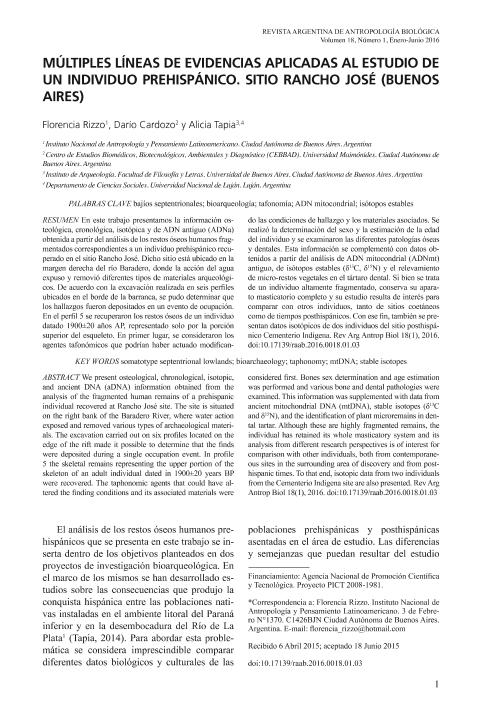Artículo
En este trabajo presentamos la información osteológica,cronológica, isotópica y de ADN antiguo (ADNa)obtenida a partir del análisis de los restos óseos humanos fragmentadoscorrespondientes a un individuo prehispánico recuperadoen el sitio Rancho José. Dicho sitio está ubicado en lamargen derecha del río Baradero, donde la acción del aguaexpuso y removió diferentes tipos de materiales arqueológicos.De acuerdo con la excavación realizada en seis perfilesubicados en el borde de la barranca, se pudo determinar quelos hallazgos fueron depositados en un evento de ocupación.En el perfil 5 se recuperaron los restos óseos de un individuodatado 1900±20 años AP, representado solo por la porciónsuperior del esqueleto. En primer lugar, se consideraron losagentes tafonómicos que podrían haber actuado modifican-PALABRAS CLAVE bajíos septentrionales; bioarqueología; tafonomía; ADN mitocondrial; isótopos establesdo las condiciones de hallazgo y los materiales asociados. Serealizó la determinación del sexo y la estimación de la edaddel individuo y se examinaron las diferentes patologías óseasy dentales. Esta información se complementó con datos obtenidosa partir del análisis de ADN mitocondrial (ADNmt)antiguo, de isótopos estables (δ13C, δ15N) y el relevamientode micro-restos vegetales en el tártaro dental. Si bien se tratade un individuo altamente fragmentado, conserva su aparatomasticatorio completo y su estudio resulta de interés paracomparar con otros individuos, tanto de sitios coetáneoscomo de tiempos posthispánicos. Con ese fin, también se presentandatos isotópicos de dos individuos del sitio posthispánicoCementerio Indígena. We present osteological, chronological, isotopic, and ancient DNA (aDNA) information obtained from the analysis of the fragmented human remains of a prehispanic individual recovered at Rancho José site. The site is situated on the right bank of the Baradero River, where water action exposed and removed various types of archaeological materials. The excavation carried out on six profiles located on the edge of the rift made it possible to determine that the finds were deposited during a single occupation event. In profile 5 the skeletal remains representing the upper portion of the skeleton of an adult individual dated in 1900±20 years BP were recovered. The taphonomic agents that could have altered the finding conditions and its associated materials were considered first. Bones sex determination and age estimation was performed and various bone and dental pathologies were examined. This information was supplemented with data from ancient mitochondrial DNA (mtDNA), stable isotopes (δ13C and δ15N), and the identification of plant microremains in dental tartar. Although these are highly fragmented remains, the individual has retained its whole masticatory system and its analysis from different research perspectives is of interest for comparison with other individuals, both from contemporaneous sites in the surrounding area of discovery and from posthispanic times. To that end, isotopic data from two individuals from the Cementerio Indigena site are also presented.
Múltiples líneas de evidencias aplicadas al estudio de un individuo prehispánico. Sitio Rancho José, Buenos Aires.
Fecha de publicación:
01/2016
Editorial:
Asociación Argentina de Antropología Biológica
Revista:
Revista Argentina de Antropología Biológica
ISSN:
1514-7991
e-ISSN:
1853-6387
Idioma:
Español
Tipo de recurso:
Artículo publicado
Clasificación temática:
Resumen
Archivos asociados
Licencia
Identificadores
Colecciones
Articulos(SEDE CENTRAL)
Articulos de SEDE CENTRAL
Articulos de SEDE CENTRAL
Citación
Rizzo, Florencia; Cardozo, Dario Gonzalo; Tapia, Alicia Haydee; Múltiples líneas de evidencias aplicadas al estudio de un individuo prehispánico. Sitio Rancho José, Buenos Aires.; Asociación Argentina de Antropología Biológica; Revista Argentina de Antropología Biológica; 18; 1; 1-2016; 1-15
Compartir
Altmétricas




